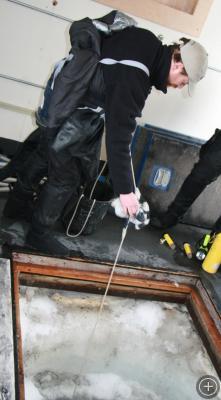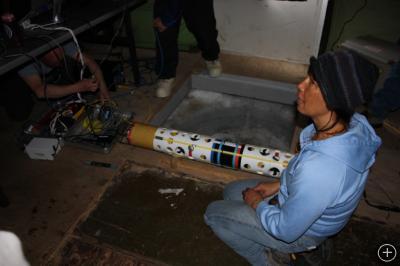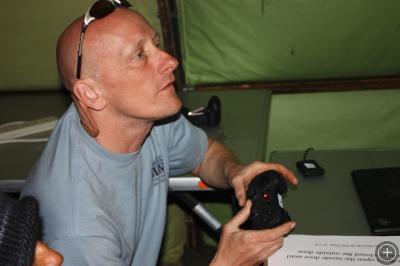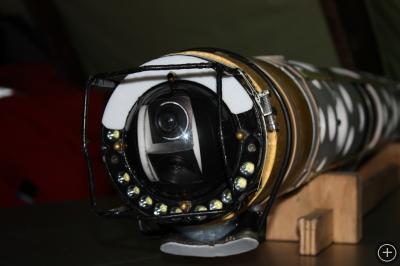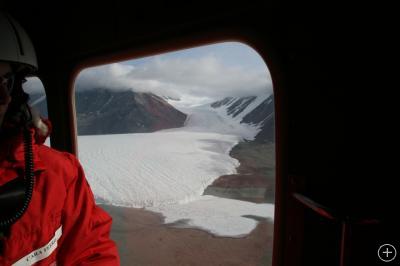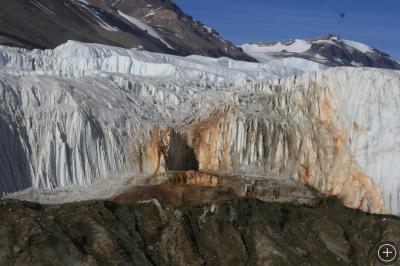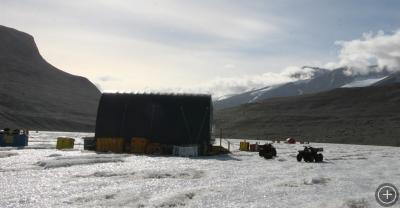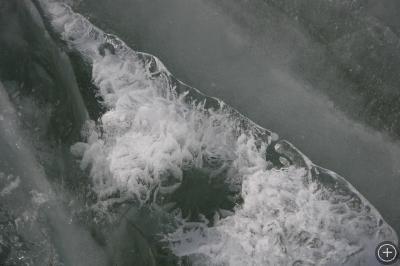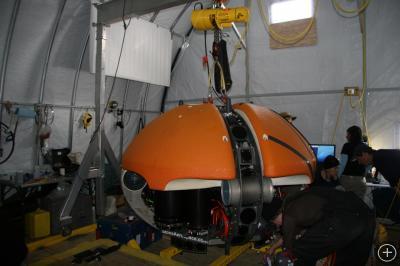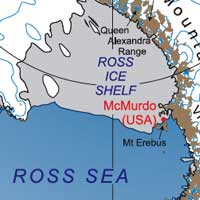Diving by Proxy
MCMURDO STATION, ANTARCTICA– Last week, we shot footage of our colleague John Weller preparing to SCUBA dive under the ice. I felt a definite pang of regret that I wasn’t joining him in the 28 degree water. On my first visit to Antarctica in 2001 for our Origins project, I had the rare privilege of diving in the clear cold water of McMurdo Sound. It was an incredible experience, the best visibility I’ve ever seen underwater and a polar sea teeming with invertebrates, fish, and giant sponges. I was diving with guitarist Henry Kaiser who has returned many times since to dive with Sam Bowser’s team studying giant foraminifera. Back in 2001, Henry shot some footage of me on my check-out dive that even made it into a film by Werner Herzog called The Wild Blue Yonder (but in my blue dry suit, only I and my mother can recognize it’s me).
Alas, on this trip to Antarctica all my underwater exploration has been by proxy through John’s photos and footage, but also through the unique under-ice vehicles SCINI and Endurance. SCINI (Submersible Capable of Under Ice Navigation) is a remote operated vehicle, or ROV, designed and operated by the team of Dr. Stacy Kim and Bob Zook of the Moss Landing Marine Laboratories. We dropped in on a SCINI demonstration the first week we were in McMurdo, an event Bob and Stacy hosted for the community here.
Here’s video of SCINI being deployed through her dive hole:
Get the Flash Player to see this player.
This slender little ROV, only six inches in diameter, can fit through an eight-inch hole drilled into the sea ice. SCINI is portable (Bob calls it a backpack ROV) so it only needs two or three people to launch and operate it. SCINI’s flexibility allows the science and engineering team to explore very remote places in waters up to 1000 feet (300 meters) deep and inaccessible to SCUBA divers. The ROV is being used by Stacy, who is a benthic ecologist, to study the creatures that live on the bottom (“benthos”) of the ocean. But it’s also a tool that can be used by lots of other scientists in many disciplines. SCINI can provide underwater eyes to ocean sediment coring operations, like ANDRILL, that let scientists see the drill core and properly adjust their setting. It can be also used to map krill distribution for David Ainley’s whale and penguin studies and to map the ocean floor.
In this video, Stacy explains how SCINI navigation works underwater:
Get the Flash Player to see this player.
Last year, Bob and Stacy used SCINI to explore some “lost” experiments in McMurdo Sound placed there in the 1960s by benthic ecologists John Oliver and Paul Dayton. Searching the sea floor with SCINI, they were able to locate these tethered experiments and hope to come back next year to collect samples from the sites. This season they took SCINI to three different locations near McMurdo station to study communities of sponges under sea ice and permanent ice shelves and also to explore areas where icebergs have scoured the bottom. For more about Stacy’s research, watch the webcast we did with them in McMurdo.
I also got a wonderful opportunity to watch the deployment of an underwater bot much larger and more complex than SCINI. Called Endurance (or affectionately dubbed “phatty” by Stacy Kim) this autonomous underwater vehicle, or AUV, was developed by Stone Aerospace and funded by NASA. The research camp at Lake Bonney in the McMurdo Dry Valleys is being run by Peter Doran of the University of Illinois in Chicago with funding from the National Science Foundation.
Traveling by helicopter out to the site, I caught my first glimpse of Blood Falls, a famous feature on the Taylor Glacier first described by British Antarctic explorer Robert Falcon Scott. The striking color comes from an iron-containing salt, ferrous hydroxide, that seeps out of the glacier and stains the water and ice a rusty red. After landing, I strapped ice stabilizers on my boots and headed out on my first walk on a frozen lake. The patterns of the ice were gorgeous.
Arriving at a big canvas-covered “garage” on the lake ice, I watched as the roughly spherical-shaped Endurance was deployed. Endurance requires a much larger hole than SCINI and the use of a hoist and several people to guide it into and down the ice hole. Once through the ice, the bot is programmed to take measurements throughout the water column, map the bottom of Lake Bonney and probe for evidence of microbial life. For this experiment, the bot is tethered with a fiber-optic cable that can send photos back to the team in the tent and keep track of its whereabouts.
Enurance is being used in the Dry Valleys LTER (Long Term Ecological Research) program to better understand the ecosystem of Lake Bonney. But a scaled-down version of Endurance could one day probe under the ice of Jupiter’s moon Europa, perhaps the best candidate for finding water and alien microbial life in our solar system.

 No comments
No comments 